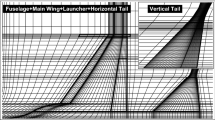Abstract
Fuel sloshing during rapid maneuvers of an aircraft causes significant loads on internal components, which in severe circumstances may break components or pipes and cause fuel to leak out of the fuel tank. Moreover, a significant load is applied to the joints of an external fuel tank by such sloshing movements. This may affect the survivability of the crew as well as the safety of the aircraft, when the joints of the external fuel tank are damaged due to a design that does not accommodate the sloshing load. Therefore, to improve the survivability of aircraft and crew members, the design of external fuel tanks should be performed after estimating the structural soundness for the sloshing load through a numerical analysis of the fuel sloshing conditions. In this study, numerical analysis was performed for a sloshing test of an external fuel tank for rotorcraft. The ALE (Arbitrary Lagrangian–Eulerian) technique was used among the methods of FSI (fluid–structure interaction analysis) and the test conditions specified in the US. Military Specifications (MIL-DTL-27422D) were applied as the conditions for the sloshing movement. As a result of the numerical analysis, the structural soundness of the joints was estimated based on the load imposed on the joints of the external fuel tank. The effects of the sloshing movement on structural soundness were assessed using a margin of safety and the failure index. These were based on the stress to the internal components, metal fittings, and the composite container.




















Similar content being viewed by others
References
Nho In Sik, Ki Min-Seok, Kim Sung-Chan (2011) A Study on simplified sloshing impact response analysis for membrane-type LNG cargo containment system. J Soc Nav Archit Korea 48(5):451–456. https://doi.org/10.3744/SNAK.2011.48.5.451
Graczyk M, Moan T (2008) A probabilistic assessment of design sloshing pressure time histories in LNG tanks. Ocean Eng 35:834–855. https://doi.org/10.1016/j.oceaneng.2008.01.020
Kim Hyun-Gi, Kim Sung Chan, Lee Jong Won, Hwang In Hee et al (2011) Slosh & vibration qualification test for fuel tank of rotorcraft. J Korea Acad Ind Coop Soc 14(1):62–68. https://doi.org/10.9766/KIMST.2011.14.1.062
Ohayon R, Soize C (2014) Vibration of structures containing compressible liquids with surface tension and sloshing effects. Reduced-order model. Comput Mech 55(6):1071–1078. https://doi.org/10.1007/s00466-014-1091-4
El Kamali M, Schotté J-S, Ohayon R (2011) Three-dimensional modal analysis of sloshing under surface tension. Int J Numer Methods Eng 65(1–3):87–105
Farhat Charbel, Chiu Edmond Kwan-Yu, Amsallem David, Schotté Jean-Sébastien, Ohayon Roger (2013) Modeling of fuel sloshing and its physical effects on flutter. AIAA J 51(9):2252–2265. https://doi.org/10.2514/1.J052299
Chang FK, Chang KY (1987) A progressive damage model for laminated composites containing stress concentrations. J Compos Mater 21:834–855. https://doi.org/10.1177/002199838702100904
Hashin Z (1980) Failure criteria for unidirectional fiber composites. J Appl Mech 47(2):329–334. https://doi.org/10.1115/1.3153664
LS-DYNA Keyword user’s manual volume II material models. Livermore Software Technology Corporation. 2014. http://ftp.lstc.com/anonymous/outgoing/jday/manuals/LS-DYNA_manual_Vol_II_R7.1.pdf
US Army Aviation and Missile Command, Detail Specification for the Tank, Fuel, Crash-Resistant, Ballistic-Tolerant, Aircraft, MIL-DTL-27422D. 2007
LS-DYNA Aerospace Working Group Modeling Guidelines Document, version 13-1, 30 August, 2013. https://www.predictiveengineering.com/sites/default/files/awg_ls-dyna_modeling_guidelings_document_v13-1.pdf.
Kim Sung Chan, Kim Hyun-Gi (2019) ALE numerical simulation of the crash impact test of an external auxiliary fuel tank. Int J Crashworthiness. https://doi.org/10.1080/13588265.2018.1495594(on-line published)
Kim Hyun-Gi, Kim Sung Chan (2019) A numerical study on the influence of the amount of internal fuel in a bird strike test for the external auxiliary fuel tank of rotorcraft. Int J Crashworthiness 24(2):137–151. https://doi.org/10.1080/13588265.2017.1410339
Kim Hyun-Gi, Kim Sung Chan (2014) Numerical simulation of crash impact test for fuel cell group of rotorcraft. Int J Crashworthiness 19(6):639–652. https://doi.org/10.1080/13588265.2014.940130
LS-DYNA Keyword user’s manual volume I. Livermore Software Technology Corporation. 2014. http://ftp.lstc.com/anonymous/outgoing/jday/manuals/LS-DYNA_manual_Vol_I_R7.1.pdf
Author information
Authors and Affiliations
Corresponding author
Additional information
Publisher's Note
Springer Nature remains neutral with regard to jurisdictional claims in published maps and institutional affiliations.
Rights and permissions
About this article
Cite this article
Kim, S.C., Kim, HG. Numerical Analysis of Structural Soundness by Sloshing Movement in an External Fuel Tank for Rotorcraft. Int. J. Aeronaut. Space Sci. 21, 380–393 (2020). https://doi.org/10.1007/s42405-019-00226-w
Received:
Revised:
Accepted:
Published:
Issue Date:
DOI: https://doi.org/10.1007/s42405-019-00226-w




